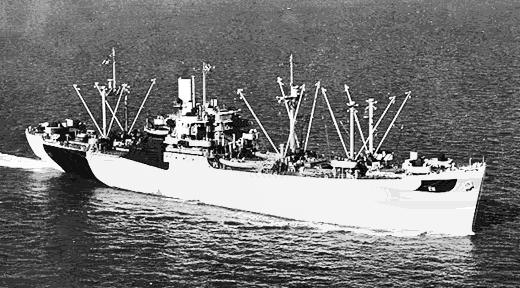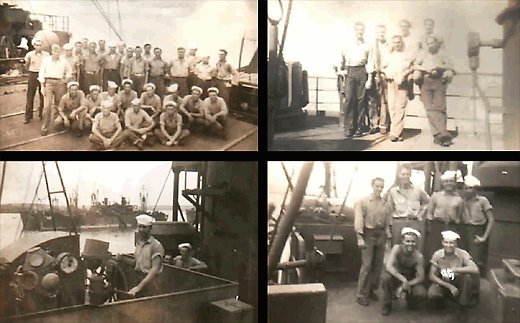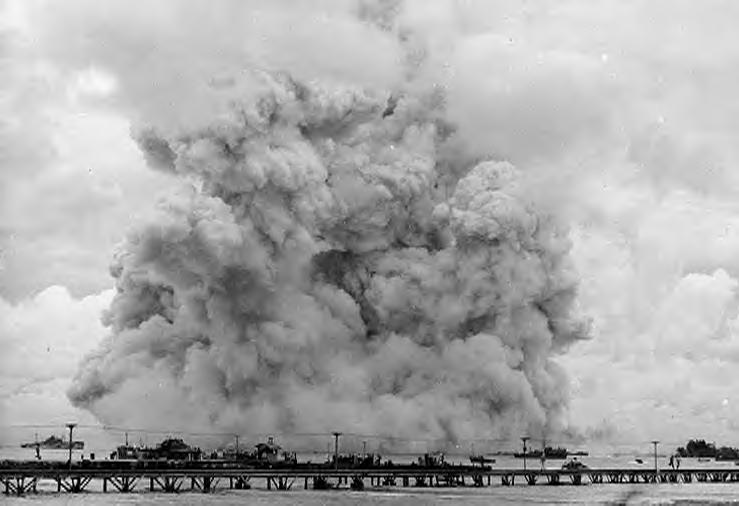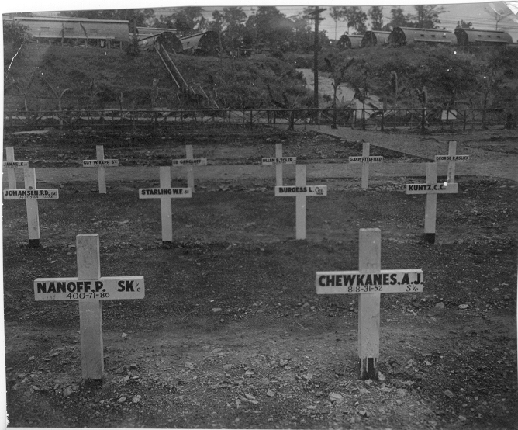The USS Rainier Page Recalls the USS Mt Hood Disaster-
A Tribute to Our Fallen Shipmates and a Reminder of the
Perils Always Faced by AE Sailors
(You're listening to the Navy Hymn, "Eternal Father, Strong to Save" in Memory of Those who lost their lives in the Mt Hood Disaster.)
The USS Mount Hood (AE-11)Explosion:
The Official Investigation
and Eyewitness Accounts by Survivors
The Ammunition Ship USS Mt. Hood (AE-11) blew up on 10 NOV 1944 at Seeadler Harbor, Manus Island, northeast of New Guinea, with great loss of life and extensive damage to shore installations and other vessels in the area. Following an investigation the following conclusions were reached by the Navy as to the explosion and the reasons for it. Following those conclusions are the observations of a survivor, Archie Trader and other eyewitnesses to events surrounding the explosion:
USS MOUNT HOOD
EXPLOSION OF AN AMMUNITION SHIP IN WORLD WAR TWO
1.) THE RECORD OF PROCEEDINGS IN THE BOARD OF INVESTIGATION WHICH CONVENED TO INQUIRE INTO THE EXPLOSION OCCURRING ON BOARD AN AMMUNITION SHIP IN THE PACIFIC THEATRE OF OPERATIONS WAS RECENTLY REVIEWED BY THE CHIEF OF NAVAL OPERATIONS, TOGETHER WITH PRELIMINARY REPORTS AND ABSTRACTS OF THE EXPOLSION PREPARED BY THE CHIEF OF ORDNANCE AND THE ARMY-NAVY EXPLOSION SAFETY BOARD. IN VIEW OF THE FACT THAT THE EVIDENCE STRONGLY POINTS TO THE CONCLUSION THAT THE EXPLOSION WAS CAUSED BY A FORCE OR AGENCY WITHIN THE SHIP ITSELF, IT IS DEEMED APPROPRIATE TO GIVE A BRIEF RESUME OF THE EXPLOSION AND POINT OUT SOME OF THE UNSAFE PRACTICES WHICH EXISTED AND TO INDICATE THE DAMAGES WHICH RESULTED FROM THE EXPLOSION.BRIEF DESCRIPTION:
AN AMMUNITION SHIP MOORED IN THE HARBOR WAS ACTING AS AN AMMUNITION DEPOT, BOTH RECEIVING AND DELIVERING AMMUNITION TO OTHER SHIPS AND LIGHTERS SIMULTANEOUSLY. SHIP'S CREW AND OTHER PERSONNEL WERE WORKING ON ALL FIVE HOLDS OF THE SHIP. AN EXPLOSION ON BOARD DESTROYED THE SHIP AND OTHER SHIPPING NEARBY AND HEAVILY DAMAGED VESSELS MOORED AT CONSIDERABLE DISTANCE FROM IT.
TYPE OF AMMUNITION:
THERE WERE APPROXIMATELY 3,800 TONS OF AMMUNITION ABOARD. THIS INCLUDED BOMBS, PROJECTILES, FIXED AMMUNITION, ROCKETS, BOTH BODIES AND MOTORS, SMOKELESS POWDER, AERIAL DEPTH BOMBS, AND NOSE FUZES. TORPEX LOADED DEPTH BOMBS WERE APPARENTLY COMING ON BOARD.
CAUSE OF THE ACCIDENT:
SINCE THE POSSIBILITY OF ENEMY ACTION APPEARS TO HAVE BEEN REMOTE, THE MOST PROBABLE CAUSE OF THE ACCIDENT APPEARS TO HAVE BEEN ROUGH HANDLING OF THE AMMUNITION WHILE LOADING OR UNLOADING. THE PROPAGATION OF THE EXPLOSION WAS UNDOUBTEDLY INCREASED BY INADEQUATE SEPARATION AND SEGREGATION OF INCOMPATIBLE ITEMS IN STOWAGE. EVIDENCE INDICATES THE POSSIBILITY OF THE DETONATION OF TPX-LOADED DEPTH BOMBS WHILE IT WAS BEING LOADED INTO NUMBER THREE OR FOUR HOLD. DETONATION COULD HAVE BEEN CAUSED BY STRIKING THE HATCH WITH THE BOMBS ON THE WAY DOWN OR DROPPING THEM INTO THE HOLD CARELESSLY.
THE FOLLOWING UNSAFE PROCEDURES AND PRACTICES WERE REVEALED BY THE INVESTIGATION:
(A) THAT AMMUNITION WAS BEING ROUGHLY HANDLED IN ALL PARTS OF THE SHIP
(B) THAT BOOSTERS, FUZES AND DETONATORS WERE STOWED TOGETHER IN ONE HOLD IN A MANNER CONTRARY TO REGULATIONS COVERING THE TRANSPORTATION OF MILITARY EXPLOSIVES (USCG-NAVCG 108)
(C) THAT BROKEN ROCKETS FROM WHICH SOME POWDER WAS SPILLED HAD BEEN STOWED IN TWO OF THE HOLDS.
(D) THAT SAFETY REGULATIONS FOR THE HANDLING OF AMMUNITIONS WERE NOT POSTED IN CONSPICUOUS PLACES THROUGHOUT THE SHIP AND THERE WAS A GENERAL LACK OF INSTRUCTIONS TO THE CREW IN SAFETY MEASURES.
(E) THAT PYROTECHNICS AND NAPALM GEL INCENDIARIES WERE STOWED IN AN OPEN WOOD AND TAR-PAPER HUT ON DECK UNDER HAZARDOUS CONDITIONS NEAR THE HATCH TO NUMBER FOUR HOLD.
(F) THAT THERE WAS EVIDENCE THAT FUZES, DETONATORS AND OTHER AMMUNITION WERE ACCEPTED ON BOARD WHICH WERE DEFINITELY DEFECTIVE AND SHOULD HAVE BEEN DESTROYED OR DISPOSED OF BY DUMPING IN DEEP WATER.
(G) THAT FIRE HOSES WERE NOT LAID OUT. THERE WAS EVIDENCE THAT FIRE DRILLS WERE INFREQUENTLY HELD.
(H) THAT THERE WAS A LACK OF ENFORCING THE PROHIBITION OF SMOKING IN SMALL BOATS ALONGSIDE THE AMMUNITION VESSEL.
FATALITIES AND INJURIES:
THIS EXPLOSION CAUSED THE DEATHS OF SEVERAL HUNDRED PEOPLE INCLUDING ALL THOSE ON BOARD THE SHIP AND THE VESSELS MOORED ALONG THE SIDE. IN ADDITION THERE WERE MANY INJURED, MOSTLY BY MISSILES ON OTHER SHIPS IN THE VICINITY OF THE EXPLOSION.
DESCRIPTION OF EXPLOSION:
WITNESSES SAW AT FIRST A SMALL EXPLOSION, ABOUT THE SIZE OF THAT OF A SINGLE BOMB, FOLLOWED A FEW SECONDS LATER BY THE MAIN EXPLOSION. THE FLAME AND SMOKE FROM THIS EXPLOSION EXTENDED ABOUT 1,00 FEET IN RADIUS AND ROSE 7,000 FEET.
2.0 THE IMPORTANCE OF CREATING AND MAINTAINING A SAFETY CONSCIOUSNESS ON THE PART OF OFFICERS AND MEN ENGAGED IN THE HANDLING OF EXPLOSIVES CANNOT BE TOO STRONGLY STRESSED. THERE IS A SAFE WAY TO HANDLE EVERY TYPE OF AMMUNITION WHICH HAS BEEN ISSUED TO THE NAVAL SERVICE PROVIDING THAT IT HAS NOT BECOME DEFECTIVE THROUGH IMPROPER STOWAGE AND MISTREATMENT. ADEQUATE INSTRUCTION HAVE BEEN PROMULGATED TO THAT END BY THE DEPARTMENT OF ORDNANCE. IT IS THE RESPONSIBILITY OF ALL COGNIZANT PERSONNEL TO GUARD AGAINST A RELAXATION OF PRESCRIBED SAFTEY STANDARDS DUE TO CARELESSNESS ON THE PART OF PERSONNEL ENGAGED IN AMMUNITION HANDLING. THIS MUST ESPECIALLY BE GUARDED AGAINST IN THE CASE OF PERSONNEL WHO ARE HABITUALLY ENGAGED IN SUCH WORK. CONSTANT TRAINING OF PERSONNEL ON THE CORRECT HANDLING PROCEDURE IS NECESSARY SO THEY WILL RECOGNIZE UNSAFE ACTS AND REFRAIN FROM COMMITTING THEM. ACCIDENTS OF THE TYPE DESCRIBED ARE RARE, BUT THEY CAN BE PREVENTED IN MOST CASES BY THE EXERCISE OF A REASONABLE AMOUNT OF CARE AND JUDGMENT.
ANOTHER VIEW OF THE SAME EVENT BY A SURVIVOR...an E-mail from Archie Trader.
Dear Bill,
Enjoyed looking in on your USS RAINIER AE-5 Page.
I do like it and it's
what I need to jog us old salts' memories. We do have a USS "AE" Association
with a current membership of 20 ammunition ships.
I'm one of 18 survivors of the Mount Hood and
do need your help. Three years ago I received a call from Carl Hughes a
merchant seaman on the William H. McGuffy anchored in Seeadler Harbor
10 Nov.1944. He saw the Japanese Midget submarine that fired the torpedo
that blew up my ship. Have all kinds of documentation that leads to and
proves this fact.
I'll send you info that'll blow your mind like it has done to me.
Resp'lly,
Archie T.Trader
Morton,PA.19060-1817
Note: I have been trying to get the NAVY DEPT to set the record straight the Mount Hood was blown up by enemy action. Loved ones that were killed or wounded should get the Purple Heart Medal. It's a terrible burden to live with the thought" my ship mates blew themselves up."
- ae11hood@bellatlantic.net
As of July, 2001, we are informed, sadly, of the passing in 1999 of Archie Trader. Read Archie's Poem in Honor of AE Sailors, written during World War 2, but updated a little since then to honor later generations of AE crews.
Here is an an article from the Bremerton Sun newspaper about Archie Trader's Quest for Justice.
TRUE TO HIS WORD, Archie sent along all sorts of documentation on the Hood disaster. These certainly are food for thought. Here are a few excerpts:
From "The Mt. Hood Explosion", by CDR Chester Gile, USNR,Ret., (published in the US Naval Institute Proceedings, Feb., 1963)
"...Conversations must have been choked off in mid-word, gestures interrupted in mid-air, thoughts ended at mid-point. One moment she was a ship teeming with life, humming with activity. Seconds later, she was a vast black billowing bier which momentarily marked the spot where 350 US Navymen perished without a trace."
"Mount Hood was anchored in approximately 35 feet of water. the force of the explosion blasted a trench in the harbor bottom, reported by divers as 1000 feet long, 200 feet wide and 85 feet maximum depth. In the trench was found the largest piece of the ship's hull- a piece less than 100 feet in it's longest dimension. Destruction was complete. Nothing was found after the explosion except fragments of metal which struck other ships. There were no bits of human remains, no supplies of any kind, nothing that had been made of wood or paper, with the single exception of a few tattered pieces of a signal notebook, floating on the water several hundred yards away."
"The flying fragments from Mount Hood smashed into some 30 other ships and harbor craft bringing the total casualties to nearly 1000 killed or wounded. Some of the harbor craft simply vanished with all hands...."
"For some unknown reason, Mt. Hood had been anchored in the midst of the ships of the Seventh Fleet Service Force. Casualties to other vessels would have been minimized if the ammunition ship had been spotted at an isolated location a few miles down harbor, off the ammunition supply depot at Lugos, the customary anchorage for ships of this type. Somebody was at fault for designating an anchorage for Mount Hood so near to the other ships."

"There were no major combatant ships in Seeadler Harbor on 10 November. However, there were about 200 other ships in the harbor, mostly auxiliaries such as cargo ships, transports, tankers, depot ships, etc. It was fortunate the disaster did not occur a month earlier when the harbor was packed with vessels of the seventh Fleet, staging for the invasion of Leyte. I have seen photographs showing some of the 995 ships assembled in Seeadler Harbor in mid-October, 1944."
Statement of Carl Hughes of Akron Ohio, dated 10-23-97...
[I was on the fantail of the liberty ship William McGuffey] "where we had a full view of the starboard side of the USS Mount Hood, from bow to stern. ...we saw a puff of smoke originating from the Hood's midship. the smoke was immediately followed by an explosion which sent smoke and flames out of the stack one hundred plus feet in the air. In a matter of seconds another explosion occurred. The latter explosion was very intense and took out in entirety the Mt. Hood. This second explosion caused the Mt. Hood to disappear among smoke and flying debris which had projected nearly seven thousand feet into the air. After the air had cleared somewhat and visibility returned, pieces of the Hood along with its crew were found on the deck of the McGuffey."
"Before the first puff of smoke was seen coming from the Hood's stack, I saw a two man submarine break the water's surface. First I saw the submarine's periscope rise from the water...I saw the conning tower of the...submarine rise from the water four to five feet in the air. From the submarine's view, it could see the whole port and had an especially keen view of the Mt. Hood's midship. It was at this time that the submarine fired a torpedo into the Mt. Hood's midship. Immediately after the Hood took the torpedo hit the first puff of smoke was released from the smoke stack. Next I observed the ...submarine come to a 45 degree angle to the McGuffey. The submarine then fired another torpedo, causing a second wake, this time in the direction of the McGuffey. The torpedo passed the McGuffey at seventy to eighty feet from the port side, coming to rest on a sandbar. The torpedo did not explode."
Honorably,
Carl Hughes
[Notary Seal]
(Ed. Note: As noted in the official investigation report reproduced above, based on 22 days of testimony taken aboard USS Sierra following the explosion, the only conclusion, based on the evidence, was that the ship had blown up due to reasons other than enemy action.
Archie's quest is continuing, with the goal of establishing for his shipmates the recognition as casualties of enemy action they deserve. (Recently, however, he received and sent along to us a message from Japanese Naval History authorities to the effect that there were no Japanese submarines operating in the Manus area at the time of the explosion, including midget submarines.)
The Mt Hood was not the only AE believed to have been torpedoed in WW2. On January 12, 1945, while anchored in Ulithi Atoll, the USS Mazama (AE-9) was struck by a Japanese torpedo. Number one hold had 5300 tons of ammo. The number one hold was secured and the ship lived to fight another day. There was no ammunition explosion. (related by Walter Brooker, Warren McMath and Ed Schubel, 43-45)
The View from USS Piedmont- a Destroyer Tender
"On the morning of 10 November, while anchored in Seeadler Harbor, Piedmont heard two explosions to port. Mount Hood (AE-11), lying about 3,500 yards away, had blown up. No trace of Mount Hood remained. Between Mount Hood and Piedmont, Mindanao (ARG-3) was anchored and took terrible punishment from the explosion. Fire and rescue parties were immediately dispatched from Piedmont to Mindanao and ships alongside her. Though Piedmont suffered only superficial damage from the explosion, numerous 5-inch projectiles and steel fragments flew over Mindanao and landed on Piedmont's decks and superstructure, most of them ricocheting off. One man suffered fatal injuries from a direct hit by the base of a 5-inch shell. One 250 pound aerial bomb penetrated the movie locker on the boat deck while another pierced the forecastle and plowed through a tier of bunks. Fortunately neither bomb exploded and remarkably enough, personnel in both compartments escaped injury."
An Email:
From:Jay (jay@ok.azalea.net) on Tuesday, July 13 at 12:56 AM EDT
Follow-Up:
I have a friend who was an aircraft mechanic on a carrier in the harbor when the explosion occurred. "One second this big steel ship was there, then BANG! When the smoke and spray had settled, there was nothing left." Some crewmen on his ship who were looking at the Mt. Hood when it exploded reported being able to see the mud at the bottom of the harbor for an instant following the explosion.
A lot of debris rained down on the other ships. Some pieces were large enough to damage the flight deck of the carrier. A number of sailors from his ship and others were injured. No one from the Mt. Hood survived. He recalls seeing parts of bodies floating in the harbor. The largest recognizable was part of a torso. He says the harbor master was court marshalled, as the Mt. Hood should never have been tied up in such close proximity to other ships.(Ed. Note: We have no confirmation of this)
A party from his ship was returning from the Mt. Hood when the explosion occurred. Had they stayed for the lemonade they'd been offered, they'd have gone up with the ship. He claims the explosion of the Mt. Hood was one of his most vivid and memorable experiences of the war, and he survived numerous Kamikaze attacks and battles.
An Eyewitness Account:
NEW *: Mt Hood Story by Fred Mielke, from the Destroyer Whitehurst
Another Eye-Witness Account:
At 0850, local time, on 10 November 1944, USS Argonne lay moored to a buoy in Berth 14, Seeadler Harbor, when USS Mount Hood (AE-11) (Ammunition Ship-11) blew up, 1,100 yards away. "At the time of the explosion," wrote USS Argonne's captain, Commander T. H. Escott, "I was standing outside my cabin...in conversation with the executive officer. By the time we had recovered our stance from the force of the explosion, and faced outboard, the area in the vicinity of Berth 380 (where USS Mount Hood had lay moored) was completely shrouded in a pall of dense black smoke. It was not possible to see anything worth reporting. A second or so thereafter, fragments of steel and shrapnel began falling on and around this ship."
Some 221 pieces of debris, ranging in size from one to 150 pounds, were recovered on board, totalling 1,300 pounds. Several other pieces caromed off USS Argonne's port side into the water alongside, and others landed on YF-681 (Freight Lighter-681) and YO-77 (Oil Barge -77), the latter alongside delivering fuel oil at the time. USS Mindanao (ARG-3) (Internal Combustion Engine Repair Ship-3), suffered heavily, moored in a berth between the disintegrating ammunition ship and USS Argonne. Riddled with shrapnel, USS Mindanao suffered 23 killed and 174 wounded in the explosion. USS Argonne suffered casualties, too, as well as the destruction of a 12-inch searchlight, five transmitting antennas broken away, and steam, fresh-water, and salt-water lines ruptured...as well as extensive damage from concussion.
(Source: USS Argonne Web Site)
Hood Crewmen- All Unidentified, Undated from the HyperWar Website

An E Mail:
Mr Freeman:
Thank you for your webpage on the Mt Hood Disaster. Since September 15, 1999, I have been searching for information concerning the death of my Uncle on the USS Mindanao (at Manus), November 10, 1944. My father, like many from WWII, rarely talked about the war and we knew little about his brother's death until my father's passing when we found letters written by the navy about my uncle's death. A letter from a shipmate informed my grandmother that her son was standing on the deck of the USS Mindanao when another ship blew up and he was hit by falling debris. That is all she was told.
I am very interested in the survivors' account of a submarine assault and the survivors' attempts to achieve purple heart status for those that died that day. My lone surviving uncle, who was also in WWII, would take great comfort from the knowledge that his brother did not die as the result of "an accident".
I will keep searching for more information concerning this event or someone I can contact and I would be very grateful for any help that you can give! Thank You!
Sincerely,Jan Johnson --- marcysjj@earthlink.net
Another E-Mail From an Eyewitness- An Aerial Attack?
Subj: Mt Hood Disaster
Date: 3/23/2002 11:07:22 AM Pacific Standard Time
From: Jadsd4
To: WMFreeman
I read the articles about Mt Hood referenced in your site with great interest and wanted to give my personal account of the Mt Hood Disaster. My name is Edward L. Ponichtera. I reside at 251 Mt. Pleasant Street, New Bedford, MA. I have some information that might interest you.
On November 10, 1944 I was a direct eye witness to the Mt. Hood Disaster.
From December 1943 to April 1946, I was in the United States Navy as an aviation ordnanceman. In November 1944 I was stationed on one of the Admiralty Islands. It was the smallest island in the group, the name was "Pytilu" (sp?). The Navy had used this island as a naval air service unit. It was called "Casu13" and "Casu42" which meant combat air service unit for the seventh fleet of the navy. As aircraft and ordinance required maintenance part of my duties on the island was to service and maintain aircraft. The island was also used to store normal type or ordinance weapons, bombs, projectiles, etc.
On November 10, 1944 I was checking 500 lb. bombs for leakage from the nose fuze area, since these were stored at the seashore and likely to leak or become unstable in the high tropical temperatures. A large ship was anchored in the harbor in front of where I was working on the beach. As I was on the beach doing my tasks I distinctly recall hearing a loud engine noise coming from the direction of the bay area. This caught my attention and I looked up and saw the silhouette of a twin engine Japanese "Betty" aircraft flying very low, just over the water, and heading directly for the freighter anchored in the bay. The sky was clear and nothing obstructed my view. I recall the day being bright with sunshine, as were most days on the island. As the plane got closer to the freighter, I clearly observed the Japanese symbol - the Rising Sun , painted on the plane. The Japanese Betty flew directly over the freighter and dropped two bombs - each a direct hit on the deck of the freighter. The Japanese airplane quickly departed and no return airfire or pursuit was followed by the navy. The ship instantly exploded into fireworks like the fourth of July. The Japanese plane disappeared and was totally obscured by the smoke and debris from the freighter.
I later learned that the freighter was the Mount Hood.
This is my recollection of this terrible tragedy. I hope that this information may be of interest to you. I will welcome your reply.
Very truly yours,
Edward L. Ponichtera
Another Eyewitness View:
From Hardy Pratt, reproduced from the Marcus Island Reunion Association page, www.marcusisland.com:
THE MT. HOOD EXPLOSION
On November 3, 1944, we had returned to Manus Island and Seeadler harbor
following the Leyte Gulf action.
On 10 November, two of us were taking a smoke break from CIC. We were on
the starboard catwalk, just forward of the Island.
I was leaning on the railing and staring out at nothing in particular. Then
there was a tremendous explosion and cloud of smoke. It was about two miles
(guesstimate) from us. We were to learn that it was the ammunition ship, Mt.
Hood. We were told that there were eight survivors...all on a mail party on
Manus.
It was really something to witness. Simultaneously, with the explosion, we
saw a motor whaleboat get turned a full 90 degrees from its course.
The explosion sent debris and 4' X 8' steel plates perhaps 2000 feet in the
air. The stuff fluttered down like they were mere matchbox pieces. The cloud
that it produced was similar to we what were to later recognize as the
signature "mushroom cloud" identified with the atom bomb.
We knew that other ships, anchored near her had to have been seriously
damaged and perhaps even some Island facilities as well. We wondered where
all the debris would land and what damage it would cause.
To my knowledge, it was never discovered what caused the explosion, but
there was no inference as to enemy involvement.
I often wonder who was with me at that time? Perhaps Robert Rainville, I'm
not sure. I do know that there are many others who saw the happening and,
like me, will remember it well. It represented a great loss of human life.
It makes you wonder what type of person crews on an ammunition ship? They
surely possess a brand of courage that I lack. If I were serving on board an
ammunition ship, I'd have the perpetual "Don Knots" shakes.
One of the Victims
From the Gennesse County Memorial Page:
Albert Allen (Junior) Edwards, on son of Mr. and Mrs. Albert J. Edwards of LeRoy, New York, was born January 8, 1926 in Stafford. Junior lived in the Griswold Road farm home 18 years. He attended district school. He was awarded a Good Citizenship Medal at 14. He took part in all athletics in South Byron School. Belonged to Byron Juvenile Grange and 4H, taking second prize, County Fair on a heifer. He was a member of St. Paulís Church, Stafford.
Junior was inducted at 18 into the U. S. Navy, March 27, 1944. He trained at Sampson Naval Base, was assigned to the USS Mt. Hood and trained further at Newport, R. I. The ship was commissioned August, 1944. Junior went to Manus Island in the Admiralties in the Pacific. He was stationed there as S 2/C V-6SV, USNR two months.
On November 10, 1944 the USS Mt. Hood was accidentally blown up. Junior and 300 shipmates were killed. Where our beloved son lies, is a sacred spot we will cherish in our memory forever; no cross or countryís flag marks his grave.
November 10, 1945 St Paulís Church, Stafford held a memorial service for Albert Allan Edwards. He was awarded Asiatic-Pacific and American Campaign ribbons.
God Bless Them All
PHOTOS

The Explosion of USS Mt. Hood at Seeadler Harbor- 1944
The Mt Hood Cemetery at Manus



Our thanks to Richard Blanchette for the three cemetery photos
Return to the USS Rainier page
SiteRing by Bravenet.com









